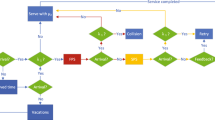Abstract
Quality of experience (QoE) is widely applied to reflect user’s satisfaction of the network service, which exactly conforms to the user-centric concept in 5G. In this paper, we propose a QoE-based subcarrier and power allocation algorithm for the downlink transmission of a multiuser multiservice system. For the subcarrier allocation algorithm, the rate proportional fairness factor is defined to ensure the fairness between users. Based on different QoE models of three services, i.e., file down (FD), video streaming and voice over internet protocol (VOIP), a multi-objective optimization method is exploited to allocate the power resource by minimizing the total power consumption and maximizing the mean opinion score (MOS) value of users simultaneously. Simulation results indicate that the proposed algorithm has less power consumption and higher QoE performance than the traditional proportional fairness (PF) algorithm. In addition, the proposed algorithm can achieve nearly the same fairness performance as the PF algorithm. Moreover, when the number of subcarriers becomes larger, the power assumption will be less but with little influence on both the QoE and fairness performances.
创新点
为了有效的提升无线通信系统的能源效率和整体性能, 本文提出了一种基于用户体验质量的高 能效的频率功率分配算法。针对多业务多用户网络系统中存在的各方面性能不均衡性以及系统 具有较高能耗的问题, 分别对无线通信系统中的频谱资源和功率资源进行优化分配。本文的 创新点在于利用多目标优化技术, 同时实现了优化系统能效, 用户平均QoE和用户公平性的目标。
Similar content being viewed by others
References
Kuo W H, Liao W J. Utility-based resource allocation in wireless networks. IEEE Trans Wirel Commun, 2007, 6: 3600–3606
Zhao M C, Gong X Y, Liang J. Scheduling and resource allocation for wireless dynamic adaptive streaming of scalable videos over HTTP. In: Proceedings of IEEE International Conference on Communications (ICC), Sydney, 2014. 1681–1686
Xing C W, Ma S D, Zhou Y Q. Matrix-monotonic optimization for MIMO systems. IEEE Trans Signal Process, 2012, 63: 334–348
Gohil A, Modi H, Patel S K. 5G technology of mobile communication: a survey. In: Proceedings of International Conference on Intelligent Systems and Signal Processing (ISSP), Gujarat, 2013. 288–292
Makki B, Graell i Amat A, Eriksson T. Green communication via power-optimized HARQ protocols. IEEE Trans Veh Tech, 2014, 63: 161–177
Huang C E, Leung C. Bit QoS-aware resource allocation for multi-user mixed-traffic OFDM systems. IEEE Trans Veh Tech, 2012, 61: 2067–2082
Wang Y C, Ren P Y, Gao F F. Power allocation for statistical QoS provisioning in opportunistic multi-relay DF cognitive networks. IEEE Signal Process Lett, 2013, 20: 43–46
Piamrat K, Ksentini A, Viho C. QoE-aware admission control for multimedia applications in IEEE 802.11 wireless networks. In: Proceedings of IEEE 68th Vehicular Technology Conference, Calgary, 2008. 1–5
Khan S, Thakolsri S, Steinbach E. QoE-based cross-layer optimization for wireless multiuser systems. In: Proceedings of the 18th ITC Specialist Seminar on Quality of Experience, Karlskrona, 2008. 63–72
Wang Z J, Dong Y N, Shi H X. Modeling and analysis of QoS class mapping for hybrid QoS domains using flow aggregate. In: Proceedings of the 9th International Wireless Communications and Mobile Computing Conference (IWCMC), Sardinia, 2013. 503–508
Julian D, Chiang M, Neill D O, et al. QoS and fairness constrained convex optimization of resource allocation for wireless cellular and ad hoc networks. In: Proceedings of the 21st Annual Joint Conference of the IEEE Computer and Communications Societies, New York, 2002, 2: 477–486
Kanumuri S, Cosman P C, Reibman A R, et al. Modeling packet-loss visibility in MPEG-2 video. IEEE Trans Multimedia, 2006, 8: 341–355
Venkataraman M, Chatterjee M. Inferring video QoE in real time. IEEE Netw, 2011, 25: 4–13
Xie L, Hu C, Wu W. QoE-aware power allocation algorithm in multiuser OFDM systems. In: Proceedings of the 7th International Conference on Mobile Ad-hoc and Sensor Networks (MSN), Beijing, 2011. 418–422
Li B Q, Li S, Xing C W, et al. A QoE-based OFDM resource allocation scheme for energy efficiency and quality guarantee in multiuser-multiservice system. In: Proceedings of IEEE Globecom Workshops (GC Wkshps), Anaheim, 2012. 1293–1297
Khan S, Thakolsri S, Steinbach E, et al. QoE-based cross-layer optimization for wireless multiuser systems. In: Proceedings of the 18th ITC Specialist Seminar on Quality of Experience, Karlskrona, 2008. 63–72
Cho Y, Kim H, Lee S, et al. A QoE-aware proportional fair resource allocation for multi-cell OFDMA networks. IEEE Commun Lett, 2014, 19: 82–85
Huszak A, Imre S. Analysing GoP structure and packet loss effects on error propagation in MPEG-4 video streams. In: Proceedings of the 4th International Symposiun on Communications, Control and Signal Processing, Limassol, 2010. 1–5
Zhang X, Zhang J, Huang Y. On the study of fundamental trade-offs between QoE and energy efficiency in wireless networks. Trans Emerging Telecommun Tech, 2013, 24: 259–265
Piamrat K, Ksentini A, Viho C, et al. QoE-aware admission control for multimedia applications in IEEE 802.11 wireless networks. In: Proceedings of IEEE 68th Vehicular Technology Conference, VTC 2008-Fall, Calgary, 2008. 1–5
Tan L, Zhu Z, Ge F, et al. Utility maximization resource allocation in wireless networks: methods and algorithms. IEEE Trans Syst Man Cybernetics Syst, 2015, 45: 1018–1034
Sun S S, Chen Y C, Liao W J. Utility-based resource allocation for layer-encoded IPTV multicast service in wireless relay networks. In: Proceedings of IEEE International Conference on Communications (ICC), Kyoto, 2011. 1–5
Janssen J, Vleeschauwer D, Buchli M, et al. Assessing voice quality in packet-based telephony. IEEE Internet Comput, 2002, 6: 48–56
Kelly F. Charging and rate control for elastic traffic. Eur Trans Telecommun, 1997, 8: 33–37
Khan A, Sun L, Jammeh E, et al. Quality of experience-driven adaptation scheme for video applications over wireless networks. IET Commun, 2010, 4: 1337–1347
3GPP. Further advancements for E-UTRA physical layer aspects. TR 36.814. http://www.3gpp.org/DynaReport/36814.htm
Author information
Authors and Affiliations
Corresponding author
Rights and permissions
About this article
Cite this article
Wang, N., Gong, S., Fei, Z. et al. A QoE-based jointly subcarrier and power allocation for multiuser multiservice networks. Sci. China Inf. Sci. 59, 122302 (2016). https://doi.org/10.1007/s11432-016-5552-6
Received:
Accepted:
Published:
DOI: https://doi.org/10.1007/s11432-016-5552-6




